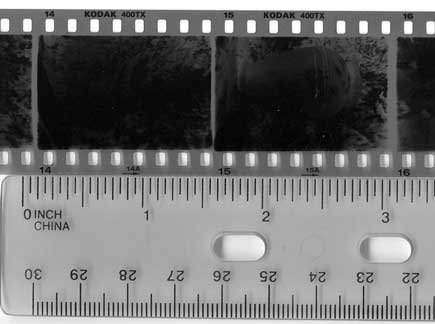135 film
135 is a film format for still photography. Introduced in its modern form in 1934 it quickly grew in popularity, surpassing 120 film by the late 1960s to become the most popular photographic film format. Despite competition from formats such as 110 and APS, it remains so today.

The film itself has the same dimensions (35 mm wide) and perforations (16 per 72 mm) as 35mm movie film but is enclosed in a light-tight cassette to allow cameras to be loaded in daylight. The standard image format is 24 × 36 mm. Other image formats were also used, like the half-frame format of 18 × 24 mm that earned some popularity during an era of unusually high film costs in the 1960s and the 24 × 24 mm of the Robot cameras. Odd formats include the 24 × 32 mm and 24 × 34 mm on the early Nikon rangefinders, and 24 × 23 mm for use with stereo cameras. In 1998, Hasselblad introduced a 24 × 65 mm panoramic format with the XPan camera. There is also a 14 × 21 mm format used by Tessina subminiature camera.
The film is housed in a single spool metal cassette. The film is clipped or taped to a spool and exits via a velvet-covered slot. The end of the film is cut on one side to form a leader, which is to be inserted into a corresponding slot in the camera take-up spool.
The film is available in lengths for varying numbers of exposures. The standard full-length roll has always been 36 exposures (assuming a standard 24 × 36 frame size). Through about 1980, 20 exposure rolls were the only shorter length with widespread availability. Since then, 20 exposure rolls have been largely discontinued in favor of 24 and 12 exposure rolls. In fact it's possible to get 3 more exposures than the nominal capacity on the film leader capacity if the camera is loaded in darkroom. 27 exposure disposable cameras are loaded in the dark with standard 24 exposure cassette. Other, mostly shorter lengths have been manufactured. There have been some 6, 8, 10, and 15 exposure rolls given away as samples, sometimes in single-use cameras, or used by insurance adjusters to document damage claims. Photographers who load their own cassettes can use any length of film -- with thinner emulsions up to 45 exposures will fit.
Ordinarily, the film must be rewound before the camera can be opened. Some cameras, particularly disposables, unwind the film fully upon loading and then expose the images in reverse order, returning the film to the cassette. This enables counting of the available exposures and protects exposed film (except the most recent images) should the camera back be accidentally opened.
Since the 1980s, film cassettes have been marked with a DX encoding pattern for automatically setting the camera.
History
The Leica camera designed by Oscar Barnack used 35 mm film and proved that a format as small as 24 mm × 36 mm was suitable for professional photography.
In the earliest days, the photographer had to load into reusable cassettes and cut the film leader. In 1934, Kodak introduced the 135 single-use cassette. It was the invention of Nagel Camerawerk in Stuttgart. Kodak bought the company, and marketed the Nagel camera as the Kodak Retina Kodak launched 135 Kodachrome color film in 1935. Agfa followed with the introduction of Agfacolor-Neu in 1936.
The designations 235 and 435 refer to 35 mm film in daylight-loading spools, that could be loaded into Leica or Contax style reusable cassettes without need of a darkroom. The 335 was a daylight loading spool for the 24 × 23 mm stereo format.
In the early 1960s, the Nikon F SLR system camera greatly improved on the quality and utility of 35mm format cameras.
The DX encoding system was introduced in the 1980s.
In 1996, a new format called APS was introduced by a consortium of photography companies in an attempt to supersede 135 film. Although it had some success, it also faced competition from digital cameras. While the 135 system remained popular, APS was officially discontinued by major manufacturers in 2004.
International standard: ISO 1007
See also: 35mm film
